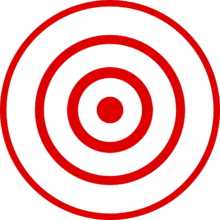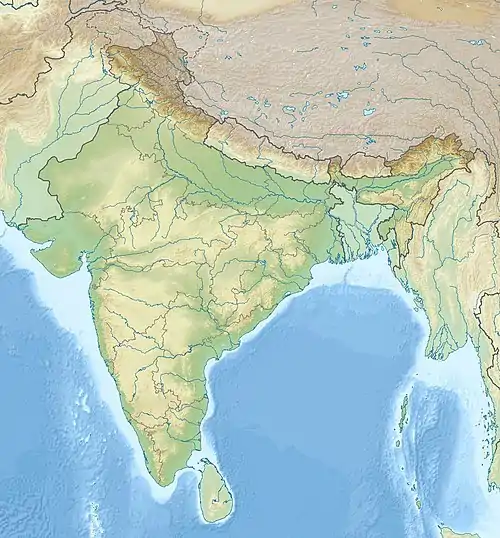    | |
| UTC time | 1993-09-29 22:25:48 |
|---|---|
| ISC event | 210578 |
| USGS-ANSS | ComCat |
| Local date | 30 September 1993 |
| Local time | 03:56 |
| Magnitude | 6.2 Mw[1] 6.3 Ms[2] |
| Depth | 10 km (6.2 mi) [1] |
| Epicenter | 18°04′N 76°37′E / 18.07°N 76.62°E [1] |
| Type | Reverse[3] |
| Areas affected | India |
| Total damage | $280 million–1.3 billion [3] |
| Max. intensity | VIII (Severe) [4] VIII (Damaging) [5] |
| Casualties | 9,748 dead [3] 30,000 injured [3] 1 million displaced[6] |
The 1993 Latur earthquake struck India at 3:56 am local time (UTC+05:30) on 30 September. The main area affected is the districts of Latur and Osmanabad, including the Ausa block of Latur and Omerga of Osmanabad in Maharashtra, Western India.[7] Fifty-two villages were demolished in the intraplate earthquake. It measured 6.2 on the moment magnitude scale, and approximately 10,000 people died,[8] whilst another 30,000 were injured. The earthquake's hypocenter was around 10 km deep – relatively shallow – allowing shock waves to cause more damage. It is considered the deadliest earthquake in the stable continental crust to have occurred in recorded history.[4]
Because the location does not lie on a plate boundary, there was some debate as to what caused the earthquake. The Indian sub-continent crumples as it pushes against Asia and pressure is released. It is possible that this pressure is released along fault lines. Another argument is that reservoir construction along the Terna was responsible for increasing pressure on fault lines. Killari,[9] where the epicenter of the quake is believed to have been, had a large crater, which remains in place to date.[10][11]
Background and geology
The Latur area, and indeed peninsular India where it is located, was previously considered having the least possibility of seismic activity. Prior to 1967 there had been only three recorded notable earthquakes in peninsular India. The Koyna earthquake, a few hundred miles west of Latur in 1967 was the most recent one.[12] Latur area is near the eastern end of Deccan Traps formed by flood basalt. The basalt flows in the area are estimated to be 450 meters thick). The terrain is generally flat.[13]
Details
- Deadliest earthquake in state of Maharashtra.[14]
- Main districts affected were Latur and Osmanabad.
- Occurred around 3.56am IST.
- 52 villages affected and destroyed.[15][16]
- 10,000 people killed and 30,000 injured.
- Huge hollow in Killari, epicentre of quake still remains.
- With measurement in moment magnitude scale of 6.4.[15]
- Casualties of being killed and injured high as it being densely populated.
- Shockwaves causing high damage as earthquake focus being 12 km deep.
- Relief teams and rescue workers with support from foreign and local support reached immediately.
- Deaths included many women and children.
- Financial assistance of Rs 46.55 lakhs for handicapped people.
- World Bank offering funding and financial and other assistance for reconstruction of Latur.
- Villagers provided with 299 cattle.
Relief efforts
Several foreign and local donors reacted immediately to the tragedy by sending relief teams and rescue workers.[14] Physicians and staff from Railway Hospital, Solapur and V.M. Medical College, Solapur were amongst the first to reach the site and assisted with treatment of the injured over the next several weeks. The first convoy of over 120 trucks laden with relief material such as tents, blankets, food and clothing, medical supplies and temporary shelters given by international donors[14] departed from Mumbai at around 10am on 2 October 1993. 42nd battalion of MIL, The Indian Army, State Reserve Police Force, Central Reserve Police Force and other law enforcement agencies rushed their personnel almost immediately after the quake,[14] assuming there would be a greater number of casualties.
See also
References
- 1 2 3 ISC (2016), ISC-GEM Global Instrumental Earthquake Catalogue (1900–2012), Version 3.0, International Seismological Centre
- ↑ "Event: MAHARASHTRA, INDIA". ngdc.noaa.gov.
- 1 2 3 4 USGS (4 September 2009), PAGER-CAT Earthquake Catalog, Version 2008_06.1, United States Geological Survey
- 1 2 National Geophysical Data Center / World Data Service (NGDC/WDS) (1972), Significant Earthquake Database, National Geophysical Data Center, NOAA, doi:10.7289/V5TD9V7K
- ↑ Harsh Gupta; Bal Krishna Rastogi (1998). "An investigation into the Latur earthquake of September 29, 1993 in southern India". Tectonophysics. 287 (1): 299-318. Bibcode:1998Tectp.287..299G. doi:10.1016/S0040-1951(98)80075-9.
- ↑ "overview of the maharashtra, india emergency earthquake rehabilitation program" (PDF). iitk.ac.in. Archived (PDF) from the original on 8 March 2022. Retrieved 15 March 2022.
- ↑ "Earth Quake". Archived from the original on 9 February 2014. Retrieved 26 August 2014.
- ↑ Somasekhar, M. (1 October 2019). "26 years on, the Latur quake has taught us many lessons". businessline. Retrieved 20 October 2021.
- ↑ "Latur earthquake 1993: September 30, a 'black day' for quake survivors in Maharashtra's Killari village - The Financial Express". The Financial Express. 26 September 2018. Retrieved 20 October 2021.
- ↑ "PHOTOS : किल्लारी भूकंप, २३ वर्षांनंतरही जखमा अजून ओल्या". divyamarathi (in Marathi). Retrieved 13 September 2018.
- ↑ "Maharashtra's deadliest earthquake: Some facts you must know about the Latur earthquake". India Today. Retrieved 13 September 2018.
- ↑ Gupta, H. K., Mohan, I., Rastogi, B. K., Rao, M. N., & Rao, C. V. R. (1993). A quick look at the Latur earthquake of 30 September 1993. Current Science, 65(7), 517–521. http://www.jstor.org/stable/24095866
- ↑ Rajendran, C. P., Rajendran, K., Unnikrishnan, K. R., & John, B. (1996). Palaeoseismic indicators in the rupture zone of the 1993 Killari (Latur) earthquake. Current Science, 70(5), 385–390. http://www.jstor.org/stable/24097438
- 1 2 3 4 "Maharashtra's deadliest earthquake: Some facts you must know about the Latur earthquake". India Today. 30 September 2015. Retrieved 20 October 2021.
- 1 2 "Only 3,500 Latur earthquake victims got jobs in 27 years: Report". Hindustan Times. 30 September 2020. Retrieved 20 October 2021.
- ↑ Aggarwal, Arshi (30 September 2018). "Killari quake: 25 years on, survivors still recovering from quake which killed 10,000". indiatvnews. Retrieved 20 October 2021.
Further reading
- Baumbach, M. & Grosser, Helmut & Schmidt, H. & Paulat, A. & Rietbrock, Andreas & Rao, C. & Raju, P. & Sarkar, D. & Mohan, Indra. (1994). Study of the Foreshocks and Aftershocks of the Intraplate Latur Earthquake of September 30, 1993, India.
- Gupta, Harsh K.; Rastogi, B.K.; Mohan, Indra; Rao, C.V.R.K.; Sarma, S.V.S.; Rao, R.U.M. (1998). "An investigation into the Latur earthquake of September 29, 1993 in southern India". Tectonophysics. 287 (1–4): 299–318. Bibcode:1998Tectp.287..299G. doi:10.1016/s0040-1951(98)80075-9. ISSN 0040-1951.
- Gupta, H. K. (10 December 1993). "The Deadly Latur Earthquake". Science. American Association for the Advancement of Science (AAAS). 262 (5140): 1666–1667X. Bibcode:1993Sci...262.1666G. doi:10.1126/science.262.5140.1666. ISSN 0036-8075. JSTOR 2885075. PMID 17781784.
- Parasuraman, S. (1995). "The Impact of the 1993 Latur-Osmanabad (Maharashtra) Earthquake on Lives, Livelihoods and Property". Disasters. 19 (2): 156–169. doi:10.1111/j.1467-7717.1995.tb00366.x. ISSN 0361-3666. PMID 7600058.
- Rajendran, C. P.; Rajendran, Kusala; John, Biju (1996). "The 1993 Killari (Latur), central India, earthquake: An example of fault reactivation in the Precambrian crust". Geology. 24 (7): 651. Bibcode:1996Geo....24..651R. doi:10.1130/0091-7613(1996)024<0651:tklcie>2.3.co;2. ISSN 0091-7613.
External links
- imd.ernet.in: LATUR EARTHQUAKE OF SEPTEMBER 30,1993
- The International Seismological Centre has a bibliography and/or authoritative data for this event.